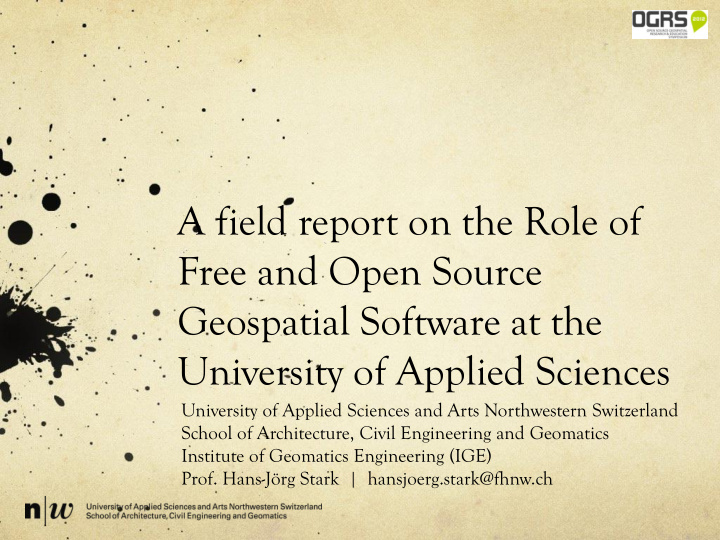



A field report on the Role of Free and Open Source Geospatial Software at the University of Applied Sciences University of Applied Sciences and Arts Northwestern Switzerland School of Architecture, Civil Engineering and Geomatics Institute of Geomatics Engineering (IGE) Prof. Hans-Jörg Stark | hansjoerg.stark@fhnw.ch
Agenda Four-Fold Ministry History Education @ IGE See You Project Pros & Cons Outlook & Suggestions
Fourfold-ministry Education: Bachelor and Master programmes Projects Applied research and development Post-graduate education
History Until 2005: GIS education mainly on proprietary GI- software 2005: First project on Free and Open Source Geospatial Software (FOSGS): Web application for people with disabilities ( Bachelor’s thesis) UMN MapServer, PostgreSQL/PostGIS Since 2006: Work on a Swiss profile for OGC web map services 2007: Launch of OpenAddresses (free – but not open…)
History continued 2008: Survey on the use of FOSGS (interdisciplinary) 2010: Migration of OpenAddresses to MapFish 2010-2012: Two research projects with ‘Bau - und Umweltdirektion Baselland’ - FOSGS as ‘must -use ’ criteria
History continued 2010-2012: Quality Checker for Swiss OWS profile ( eCH- 0056 ) on behalf of Swiss federal Organisation‘ Coordination, Geo-Information and Services (COGIS )’ 2011-2012: See-You: (www.see-- you.ch) secondary school research project
Education @ IGE Bachelor’s : mainly proprietary GI-Software (ArcGIS, Geomedia etc.) FOSGS (QGIS) growing Master’s : Python, QGIS, PostgreSQL/PostGIS, OpenLayers
See You Project Map Your World Project since 2009 Problem: complex (infrastructure, time-wise) Strategic Initiative FHNW, School of Teacher Education: Promote the interest of secondary school students in technical professions Limitation: 4 lessons!
See You Project Students record their daily routes (≈ 1 Week) GPS data is uploaded, stored and processed in a central database (PostgreSQL) Web application provides results as maps showing spatial-kinesthetic behavior and motion patterns: Heatmap of GPS tracks Hotspots Indoorlocations
See You Project Functionality web application: Computation of heatmap / hotspots etc. Filter options (time of day, day, age, gender) Movie / Animation of tracks (5‘ Interval)
See You Project Sub-tasks to do: Find out about relations based on GPS tracks Optimise GPS- Track‘s Geometries Evaluation of other areas of application (urban planning, bike couriers, etc.) Sub-tasks were integrated into education programmes ( Bachelor’s and Master’s )
Pros and Cons FOSGS (academic perspective) Pro Accessibility Costs (no costs) License Contra Documentation Support (occasional) Installation (occasional) Prerequisites (occasional) Language (English!)
Findings on FOSGS @IGE FOSGS catalyst for projects Strong FOSGS pros in academic environment FOSGS supports focussing on the task instead of on the tool (from a student’s / teacher’s perspective) Proprietary SW still necessary @IGE most students prefer the advantages of proprietary SW Proprietary SW vendors support IGE financially … With growing education level FOSGS becomes the preferred choice
Outlook & Suggestions Easier entrance level for students with «low-level skills» Educational material can be shared among teachers in academia (Tutorials, lecture notes, etc.) Strategically positions academia in the FOSGS environment: Documentation SW-testing (development – PhD students (?))
Thank you! hansjoerg.stark@fhnw.ch www.see--you.ch www.map-your-world.ch www.openaddresses.org
Recommend
More recommend